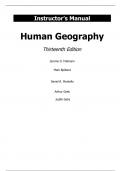Exam (elaborations)
Human Geography Landscapes of Human Activities 13th Edition By Mark Bjelland, Daniel Montello, Jerome Fellmann, Arthur Getis, Judith Getis (Instructor Manual)
- Course
- Institution
Human Geography Landscapes of Human Activities 13e Mark Bjelland, Daniel Montello, Jerome Fellmann, Arthur Getis, Judith Getis (Instructor Manual) Human Geography Landscapes of Human Activities 13e Mark Bjelland, Daniel Montello, Jerome Fellmann, Arthur Getis, Judith Getis (Instructor Manual)
[Show more]



